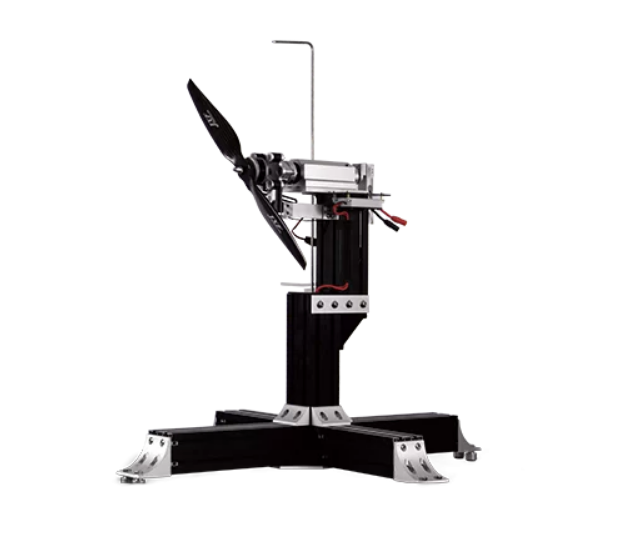May. 30, 2023
Measuring the thrust of a propeller is essential for assessing its performance, optimizing flight characteristics, and determining the efficiency of a propulsion system. Several methods can be employed to measure thrust, ranging from simple setups to more sophisticated instrumentation. Here are several common approaches for measuring propeller thrust:

A static thrust stand is a basic setup that provides a straightforward method for measuring thrust. The stand typically consists of a rigid frame, a load cell or force sensor, and a means to secure the propeller in place. The propeller is mounted horizontally, and the load cell measures the force exerted by the propeller during operation. By measuring the force, the thrust produced by the propeller can be determined. This method is relatively simple and affordable, making it suitable for initial assessments and basic thrust measurements.
A dynamometer is a more advanced and accurate instrument for measuring propeller thrust. It consists of a load cell or force sensor, a rotation sensor, and data acquisition equipment. The propeller is mounted vertically, and the load cell measures the thrust force exerted by the propeller. The rotation sensor captures the rotational speed of the propeller. By combining the force and rotational speed data, the thrust produced by the propeller can be calculated. Dynamometers provide more precise measurements and are commonly used in research, development, and performance evaluation of propulsion systems.
In addition to measuring thrust, it can be beneficial to measure the torque produced by the propeller. This additional measurement allows for the calculation of efficiency and power output. A thrust stand with torque measurement utilizes a load cell to measure thrust and a torque sensor to measure the rotational torque of the propeller. The combination of thrust and torque data provides insights into the overall performance and efficiency of the propeller and propulsion system.
Wind tunnel testing is a controlled environment that allows for comprehensive propeller performance assessment. A propeller is mounted inside a wind tunnel, where the airflow can be precisely controlled. Various sensors and instruments, including force sensors, pressure sensors, and flow measurement devices, are used to capture data related to thrust, airflow, and other relevant parameters. Wind tunnel testing provides accurate and detailed information about propeller performance under specific conditions, making it suitable for in-depth research and design optimization.
Another indirect method of measuring thrust is through flight data analysis. By equipping the UAV with sensors, such as accelerometers or inertial measurement units (IMUs), and recording flight data during controlled maneuvers, it is possible to infer thrust values based on changes in acceleration or motion. This approach requires careful data interpretation and analysis, taking into account other factors that may influence the recorded data, such as wind conditions, air density, and aerodynamic forces.
Computational Fluid Dynamics is a simulation-based method for analyzing the aerodynamic performance of a propeller. By using specialized software, engineers can simulate the flow of air around the propeller and calculate the resulting thrust. CFD allows for detailed analysis of propeller performance under various conditions and provides insights into flow patterns, pressure distribution, and other parameters. While CFD is a complex and computationally intensive method, it offers valuable insights for propeller design and optimization.
It's important to note that the measurement of thrust is influenced by various factors such as air density, temperature, humidity, and the presence of other components (e.g., ducting, shrouds, or motor housing) in the propulsion system. Calibration and correction procedures may be necessary to account for these factors and obtain accurate thrust measurements.
Measuring the thrust of a propeller is crucial for assessing its performance and optimizing the efficiency of a propulsion system. Whether using a static thrust stand, a dynamometer, wind tunnel testing, flight data analysis, computational fluid dynamics, or a combination of these methods, the goal is to obtain accurate and reliable data to inform design decisions, performance evaluations, and flight optimizations. The choice of method depends on the level of accuracy required, available resources, and the specific objectives of the measurement.
For reliable and precise motor testing, WingFlying offers a range of high-quality test stands for small, medium, and heavy propulsion systems.Interested in custom solutions? We tailor our products to meet your specific requirements. Download detailed specifications or reach out to us directly for more information.
Choose WingFlying for your propulsion testing needs and experience the difference in quality and performance
E-mail: sandy@wing-flying.com
Add.: 7th Floor, B2#,Animation Building, Sino-Singapore Tianjin Eco-City